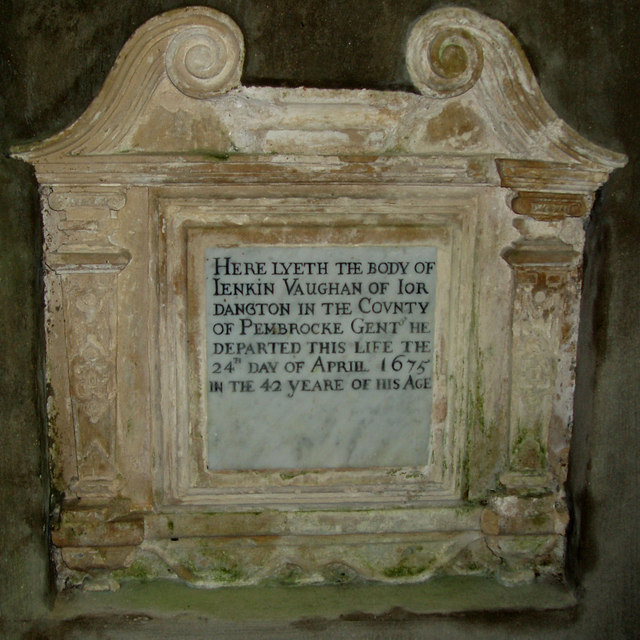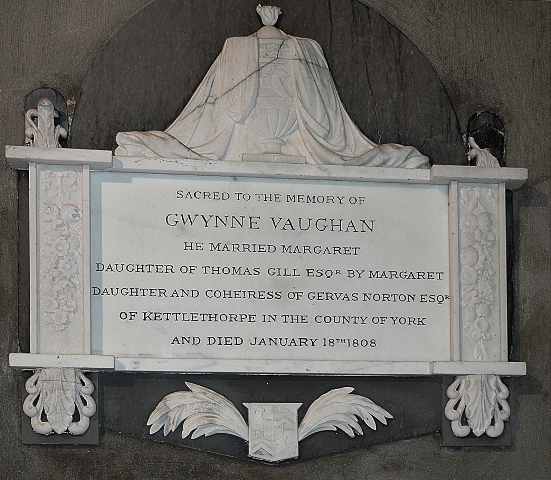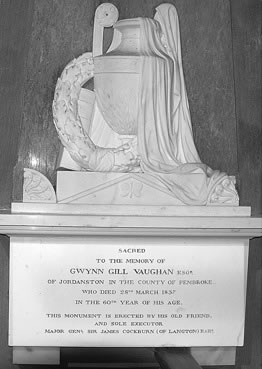The Vaughan Family of Jordanston Hall
The Vaughan family originated in Radnorshire. Their connection with Jordanston commenced when John Vaughan married the Gwynn heiress, Matilda, in the mid seventeenth century, thereby inheriting the Jordanston estate which had held by the Gwynn's since the mid sixteenth century. The Vaughans remained at Jordanston for almost two hundred years until the last of the family, Gwynn Gill Vaughan, bequeathed the estate to his friend, Sir James Cockburn.
Sir James’daughter, Marianna Augusta, married Col. Sir James John Hamilton.
The Vaughan Memorials ~ (Point 5)
The Jenkin Vaughan Plaque
John was the first of the Vaughan family to reside at Jordanston. He was succeeded by his son Jenkin who is commemorated on this fine plaque with its swan-neck pediment.
In 1659, he was accused of murdering one of his servants, Theophrastus Mellychop, but he was later exonerated.
Jenkin died in 1675 and he was succeeded by his brother Morgan, but three years later, he was dead. The estate passed to Jenkin and Morgan’s nephew, Gwynne, who was the son of their brother, Lewis, a clergyman. Gwynne died at a comparatively young age in 1700 and he was succeeded by his son, Lewis ~ (Point 16) (it is interesting to note that Gwynne’s daughter, Elizabeth, married Joseph Mahoon of Golden Square, Westminster, harpsichord-maker to George III).
Lewis died childless and he was succeeded by his brother John, who had married Anne, daughter and co-heiress of John Williams, of Gellydowill, Cenarth. John’s and Anne’s son was Gwynne Vaughan.
The Gwynne Vaughan Plaque ~ (Point 6)
Gwynne Vaughan was one of the children of John Vaughan and his wife Anne, the daughter and heiress of John Williams of Gellydowill, Cenarth. Gwynne Vaughan played a prominent part in public life. He was a J.P. and High Sheriff of Pembrokeshire in 1799, and after Fishguard had been bombarded by a privateer in 1779, he gave land on which to build Fishguard Fort. He became Governor of the Fort and along with his brother Daniel (Point 17) played an important part during the French Invasion of 1797.
It was during his church- wardenship of Jordanston that the church was restored in 1797 ~ (Point 13).
On 15th November 1774, Gwynne Vaughan married at St. George, Hanover Square, Margaret, daughter of Thomas Gill of St. Marylebone, London. They had two children, Margaret and Gwynne Gill Vaughan.
The Gwynne Gill Vaughan Plaque ~ (Point 7)
Following family tradition, Gwynne Gill Vaughan played a prominent part in local affairs and was High Sheriff of the County in 1813. He was unmarried and on his death in 1837, (his sister Margaret had predeceased him in 1836), he bequeathed the Jordanston estate to his close friend and executor, Sir James Cockburn, Bart. (1771 - 1852). Sir James was a Page of Honour to King George III, a Colonel in the Scots Greys and Governor of Bermuda in 1811.
He went on to become a Major General and Inspector of Marines in 1819.
He married the Hon. Marianna Devereux, daughter of the 13th Viscount Devereux and their daughter was Marianna Augusta who married Sir James John Hamilton.
The Vaughan Graves
(On leaving the Church, turn left)
The weathered table tombs at the south west corner of the church commemorate three members of the Vaughan family.
Grace Vaughan Tombstone ~ (Point 15)
Grace was the wife of Lewis Vaughan (Point 16). She was the daughter of Thomas Johnes of Llanfairclydogau, Cardiganshire. She died on 7th January 1746-7, aged 60.
Lewis Vaughan Tombstone ~ (Point 16)
Lewis Vauaghan was the son of Gwynne Vaughan ~ (Point 5) and his wife Mary, daughter of Dr. William Owen, D.D. of Berllan, a descendant of Pembrokeshire’s Elizabethan historian, George Owen. Like many members of his family he was active in local affairs and was High Sheriff of Pembrokeshire in 1717. On his land, Llangloffan Baptist Chapel was built in 1706, that denomination’s third chapel in Wales.
When the press gang grabbed a young man from a Baptist meeting near Castlemorris, Lewis Vaughan, on being told, jumped on his horse, sword in hand, and caught up with the press gang in Letterston. He demanded, and got, the young man released! Lewis died in 1755, aged 75 and lies buried alongside his wife Grace ~ (Point 16). The couple had no children.
The Daniel Vaughan Tombstone ~ (Point 17)
Daniel Vaughan was one of the ten children of John and Anne Vaughan and the brother of Gwynne Vaughan ~ (Point 6) . He was born around 1738, entered the army and rose to be Lieutenant Colonel of the 39th Regiment of Foot. After leaving the army he returned to live at Jordanston, and was a captain in the Fishguard Fencibles at the time of the French Invasion in 1797. On the night that the French landed – 22nd February 1797 – Gwynne and Daniel Vaughan were attending the ball given by Mrs. Harries of Tregwynt. When the news reached the assembly, Gwynne hurried off to Fishguard Fort and the story goes that Daniel loaded all the firearms he could muster to await the arrival of the foe. Luckily, they never came!
Both Gwynne and Daniel attended the ‘Council of War’ assembled at what is now known as the ‘Royal Oak’ in Fishguard, on the evening of the 23rd February 1797 to discuss with the commander, Lord Cawdor, the best way to respond to the French invaders. In May 1797, Daniel acted as the second to Col. Knox who, having been accused of cowardice when the French came, challenged Lord Cawdor to a duel. The exact outcome is unknown, but no one was injured! Daniel died, unmarried, in the December of the following year.



